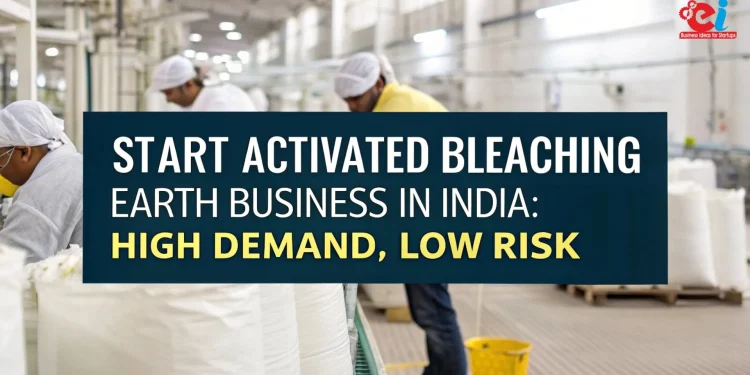The biofuel, edible oil, lubricant, and refined oil product sectors have seen a staggering growth over the last few decades. An equally important product in the oil refining and purification processes is Activated Bleaching Earth (ABE), which is mainly produced from bentonite clay. Due to its high adsorptive capacity and fine particle structure, activated bleaching earth essentially takes out all impurities and color bodies, gums, and oxidation products from oils. It helps achieve clarity, stability, and purity in the final oil product.
The raw bentonite is transformed into activated bleaching earth through acid treatment, drying, milling, and classification. All these streams should yield the stringent quality requirements of the oil refining industry. This article discusses the defined industrial role of bentonite-based activated bleaching earth, its increasing market prospects, the detailed production steps, funding needed, and the career options available to the world and Indian entrepreneurs.
NPCS Project Consultancy Services are unparalleled in this space, and offer a full scope support for entrepreneurs looking to enter into this domain. Their detailed feasibility reports coupled with industrial guidance allow ideas to be fully implemented and result in the businesses being operational.
Rising Consumption of Activated Bleaching Earth
The consumption of activated bleaching earth is paralleling the increase in demand for refined oils such as palm, soybean, sunflower, and cottonseed oil. Aside from food-grade applications, bleaching earth is used in the purification process of mineral oils, waxes, biofuels, and other petroleum derivatives. Amidst stricter regulation over oil quality and food safety standards, manufacturers are looking for more advanced bleaching media with minimal oil residue, better filtration characteristics, and easier disposal.
India is one of the largest producers and consumers of edible oils; the country also provides an ongoing and expanding supply of bleaching earth. Southeast Asia, the Middle East, Europe, and Africa are also fueling the expansionary consumption of both industrial and edible oils. Industry estimates project a USD 3-billion global bleaching earth market by 2030, representing a significant opportunity for bentonite processors and chemical manufacturers.
NIIR Project Consultancy Services has successfully prepared project reports for activated bleaching earth production units geared to Indian and export-oriented entrepreneurs. They also consider this sector to be of high potential in their industrial project catalog.
The Role of Bentonite in Bleaching Earth
Bentonite, an omnipresent clay, is composed mainly of montmorillonite which is a striated silicate mineral, rich with high surface area and has swelling properties. One of the industrial processes where value addition is done is in the production of activated bleaching earth. Bentonite naturally occurs with some deposits of impurities which call for processing to make its adsorptive properties better.
Bentonite activation consists of the removal of undesirable cations (Ca2+, Mg2+) that are infrequently associated with the clay followed by ion exchange with H⁺ leading to increase in its acidity. This enhances the area, voids, and the exchangeable cation content of the clay making it able to adsorb some pigments, chlorophyll, residues of soap, and oxidized materials present in oils.
Gujarat, Rajasthan and Tamil Nadu have the largest deposits of Bentonite clay in India. It can be activated and transformed into bleaching earth at a commercial level. Since raw material is available locally, these regions can improve their logistics cost and compete better in the domestic and export markets.
Related: Activated Carbon Market Size & Growth Report- Size, Share, Trends & Forecast
Activated Bleaching Earth from Bentonite: Manufacturing Procedure
The steps for obtaining activated bleaching earth from bentonite involve complicated processes which are mechanically, thermally, and chemically intensive. The first stage of processing is the extraction of bentonite clay, followed by crushing, and drying to eliminate moisture.
Thermally dried bentonite undergoes acid activation with either sulfuric or hydrochloric acid. Such treatment ionically modifies clay minerals by removing certain metallic ions and thereby expanding their structural framework, so as to improve their surface area and adsorption characteristics. The clay from which acid was washed continues to undergo secondary treatment wash where pH and acid residues are neutralized.
Subsequent to wash-out, the clay undergoes heat treatment aimed at removing every bound water molecule until a pre-defined moisture content is achieved. This powder is further subjected to grinding or milling so that the particles become finer and easier to disperse and filter in oil. Finally, the clay is classified and sieved in order to obtain uniform bulk density and granule size before being safely stored in moisture proof bags or containers.
Steam activation, calcination, or use of specific catalysts to enhance performance for targeted applications like petroleum wax bleaching or transformer oil purification may still be possible at advanced bleaching earth plants. Automation further ensures product consistency and steam activation or even real-time quality testing coupled with particle size evaluation guarantee superior results.
Equipment and Machinery Required
Establishing a manufacturing unit for activated bleaching earth requires setting up a plant for mineral handling, chemical processing, thermal treating, and fine powder processing. A typical plant includes the following:
- Units for crushing and screening raw bentonite
- Moisture removal rotary or flash dryers
- Reaction tanks lined with acid resistant materials for acid preparation and neutralization with high speed agitators
- Slurry Filtration Units and Filter Presses
- Final drying tray or rotary kilns
- Ball, Raymond or pulverizers mills for grinding
- Classification and sieving machines
- Storage silos, conveyers and packing machines
- Ventilation, scrubber systems and dust control
- Pouring filters for rotatable silos, automated filling in bags, flexible packing machines
- Quality control laboratory measuring surface area, pH, filtration time, and absorption for activating bleaching earth.
The operation scale determines the level of automation and capacity to the plant. Depending on target market volume and operational strategy, plants are designed for batch or continuous processing. Providing detailed equipment description, plant layout with the suppliers contacts, guidance on the integration for each machinery module and steps for further processes NIIR Project Consultancy Services collects from clients aiding them in the projected goals.
Land, Infrastructure and Utilities Needed
An industrial site of about 1.5 to 2 acres is necessary for a facility that produces approximately 5,000 tons yearly of activated bleaching earth. This includes the production shed, chemical processing area, drying zones, laboratory, utilities block, and waste handling systems.
Steam generation may be needed if thermal drying or calcination is used; a 1-2 TPH boiler with the necessary steam piping would then be required. Power requirements for the grinding, drying, and material handling equipment is 250 to 350 kVA. Water consumption acid dilution, washing, and cleaning processes also varies with plant capacity, between 15,000 to 25,000 liters daily.
Effluent and wash waters that contain acid, neutralized waters, and process residues all require wastewater treatment systems. To meet environmental compliance standards, an Effluent Treatment Plant (ETP) with pH neutralization, sedimentation, and filtration units needs to be properly designed and installed.
Compliance to Regulations and Environmental Factors
Activation of bleaching earth entails working with acid and clay dust, alongside chemicals within effluents, thus requiring compliance with certain environmental safety regulations. The unit has to obtain Consent to Establish and Consent to Operate from the State Pollution Control Board. Also Factory Act compliance and the rules of handling hazardous wastes, the working environment, and occupational health standards must be followed.
There is need for a comprehensive ETP (Effluent Treatment Plant) which will handle the treatment of acidic effluents, undergoes processes of neutralization, and safe discharge. Workers need to be trained on chemical usage and personal protective equipment such as gloves, goggles, and respiratory equipment should be provided.
In order to protect clients from incurring missed deadlines and penalties, NIIR Project Consultancy Services incorporates all statutory requirements alongside best practices for project’s environmental practices into its documentation.
Potential for Exports and Market
With potential global markets for activated bleaching earth existing in oil-producing countries in Asia, Africa and the Middle East, there is scope for India to be a supplier. Coupled with Indian manufacturers’ production cost efficiency, the availability of local bentonite, and improved port and infrastructure, India seems poised to emerge as a dominant player in the global market driven by competitive pricing and consistent quality.
Due to insufficient domestic clay deposits or a lack of processing facilities, numerous countries are still importing bleaching earth. There is an available market in Indonesia, Bangladesh, Nigeria, Kenya, UAE, Vietnam, and other emerging countries that have a rapidly increasing oil refining capacity.
Indian marketers have the opportunity to manufacture specialty bleaching clays, which are customized to specific oils or waxes, thus enabling the market to penetrate premium segments. NPCS aids in developing international strategies, export documentation, and compliance with benchmarks like REACH and ISO certifications.
Related: Projects on Activated Carbon
NIIR Project Consultancy Services: Industrial Support for Your Venture
NIIR Project Consultancy Services is a trusted name in the area of industrial project consulting and feasibility studies for industrial ventures. For prospective manufacturers of activated bleaching earth, NPCS provides comprehensive:
- Project Report with technical process description
- Market analysis and demand forecasting on demand
- Procurement and Plant layout and design
- Guideline on modeling compliance to environmental standards for the industry and safety
- Financial model design and pitch deck for potential investors
- Guidelines on licensing and registering a business
Conclusion
The activated bleaching earth industry encourages new ventures into manufacturing and processing chemical materials since it arises from bentonite. New opportunities are on the rise as the refining industry and biofuel industry continues to increase demanding high-grade bleaching clay. India’s extensive reserves of bentonite and their cheap labor gives room for construction of self-sufficient and overseas dominating industries in oil refinery outlets and processing plants.
It is clear that producing activated bleaching earth is a profitable investment and economically feasible because of the growing demand for edible oils. With India having a great bentonite reserve further adds towards the opportunity. Profits are higher if combined with well-articulated strategies, sound financing, planned globally, and building an adhering framework to worldwide requirements. NIIR Project Consultancy Services is always available to serve you on this path by offering detailed and actionable feasibility studies, business strategies, and solid direction from the start up to the operational stage.


























